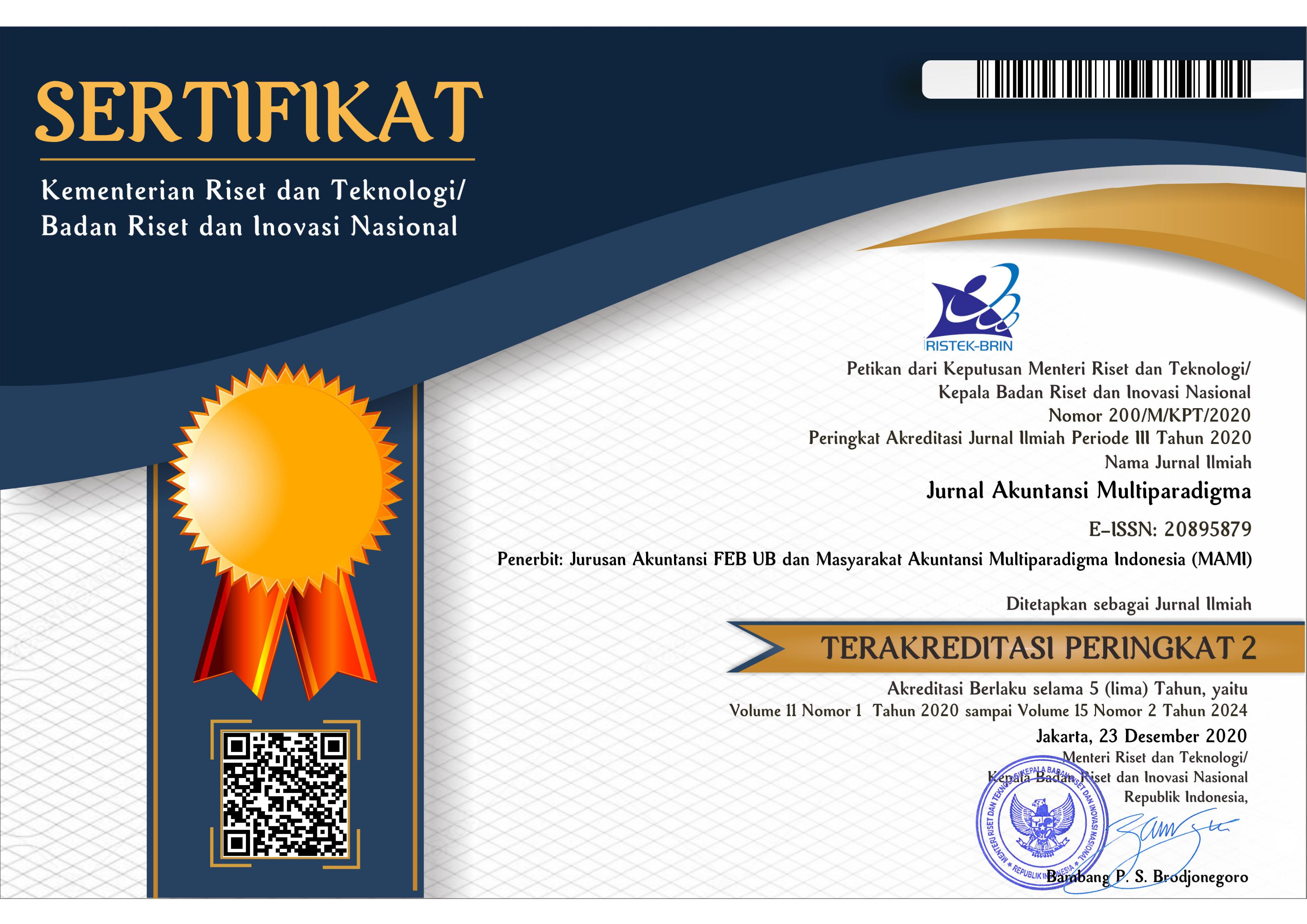INTERAKSI DOKTER, MANAJEMEN, DAN PEMILIK DALAM PRAKTIK AKUNTANSI MANAJEMEN RUMAH SAKIT
Abstract
Abstrak – Interaksi Dokter, Manajemen, dan Pemilik dalam Praktik Akuntansi Manajemen Rumah Sakit
Tujuan Utama – Penelitian ini bertujuan untuk mendeskripsikan peran akuntansi manajemen dalam menunjang hubungan dokter dan rumah sakit dalam upaya peningkatan kinerja.
Metode – Penelitian ini menggunakan pendekatan deskriptif kualitatif. Informan dalam penelitian ini adalah perwakilan pemilik, dokter, dan akuntan di sebuah rumah sakit.
Temuan Utama – Akuntansi manajemen berperan sentral dalam menyelaraskan kepentingan dokter dan rumah sakit. Peran akuntansi dijalankan melalui fungsi prediksi keberlanjutan bisnis, kendali biaya, dan pemberian insentif/bonus. Akuntansi berperan dalam menyediakan informasi untuk perhitungan, membuat formulasi dan analisis, dan menciptakan transparansi hasil perhitungan.
Implikasi Teori dan Kebijakan – Hasil penelitian konsisten dengan teori ketergantungan sumber daya. Selain itu, pada aspek praktik, akuntansi merupakan alat pemilik dan manajemen untuk menjadi penyeimbang melalui perannya dalam menyediakan informasi, analisis, dan transparansi.
Kebaruan Penelitian – Penelitian ini menghubungkan akuntansi manajemen dan perilaku dokter.
Abstract – Doctors, Management, and Owner Interactions in Hospital Management Accounting Practices
Main Purpose – This study aims to describe the role of management accounting in supporting the relationship between doctors and hospitals in an effort to improve performance.
Method – This study uses a qualitative descriptive method. The informants were representatives of owners, doctors, and accountants in a hospital.
Main Findings – Management accounting plays a central role in aligning the interests of doctors and hospitals. The role of accounting is carried out through the functions of predicting business sustainability, cost control, and incentive/bonus provision. Accounting has a rule to provide information for calculations, making formulations and analyses, and creating transparency of calculation results.
Theory and Practical Implications – The results of the study are consistent with the resource dependency theory. In addition, on the practical aspect, accounting is a tool for owners and management to be a balancer through its role in providing information, analysis, and transparency.
Novelty - This study links management accounting and physician behaviour.
Keywords
Full Text:
PDFReferences
Abatemarco, A., Beraldo, S., & Stroffolini, F. (2020). Equality of Opportunity in Health Care: Access and Equal Access Revisited. International Review of Economics, 67(1), 13-29. https://doi.org/10.1007/s12232-019-00342-9
Abdalla, R., Pavlova, M., & Groot, W. (2023). Prioritizing Outcome Measures for Value-Based Healthcare: Physicians’ Perspectives in Saudi Arabia. Value in Health Regional Issues, 37, 62-70. https://doi.org/10.1016/j.vhri.2023.05.002
Abdulsalam, Y., Gopalakrishnan, M., Maltz, A., & Schneller, E. (2018). The Impact of Physician‐Hospital Integration on Hospital Supply Management. Journal of Operations Management, 57(1), 11-22. https://doi.org/10.1016/j.jom.2018.01.001
Addo, R., Haas, M., & Goodall, S. (2021). The Cost-Effectiveness of Adjuvant Tamoxifen Treatment of Hormone Receptor–Positive Early Breast Cancer among Premenopausal and Perimenopausal Ghanaian Women. Value in Health Regional Issues, 25, 196-205. https://doi.org/10.1016/j.vhri.2021.05.005
Achtert, K., & Kerkemeyer, L. (2021). The Economic Burden of Amyotrophic Lateral Sclerosis: A Systematic Review. The European Journal of Health Economics, 22(8), 1151-1166. https://doi.org/10.1007/s10198-021-01328-7
Ackerman, S. J., Deol, G. S., & Polly, D. W. (2022). Cost-Utility Analysis of Sacroiliac Joint Fusion in High-Risk Patients Undergoing Multi-Level Lumbar Fusion to the Sacrum. ClinicoEconomics and Outcomes Research, 14, 523-535. https://doi.org/10.2147/ceor.s377132
Alsharari, N. M., & Al-Shboul, M. (2019). Evaluating Qualitative Research in Management Accounting Using the Criteria of “Convincingness”. Pacific Accounting Review, 31(1), 43-62. https://doi.org/10.1108/par-03-2016-0031
Araujo, R., Fernandes, J. M., Reis, L. P., & Beaulieu, M. (2022). Purchasing Challenges in Times of COVID-19: Resilience Practices to Mitigate Disruptions in the Health-Care Supply Chain. Journal of Global Operations and Strategic Sourcing, 16(2), 368-396. https://doi.org/10.1108/jgoss-04-2022-0026
Asante, A., Man, N., & Wiseman, V. (2020). Evaluating Equity in Health Financing Using Benefit Incidence Analysis: A Framework for Accounting for Quality of Care. Applied Health Economics and Health Policy, 18(6), 759-766. https://doi.org/10.1007/s40258-020-00597-2
Baker, L. C., Bundorf, M. K., & Kessler, D. P. (2016). The Effect of Hospital/Physician Integration on Hospital Choice. Journal of Health Economics, 50, 1–8. https://doi.org/10.1016/j.jhealeco.2016.08.006
Begkos, C., & Antonopoulou, K. (2022). Hybridization as Practice: Clinical Engagement with Performance Metrics and Accounting Technologies in the English NHS. Accounting, Auditing & Accountability Journal, 35(3), 627-657. https://doi.org/10.1108/aaaj-12-2019-4333
Bhatt, R. R., & Bhattacharya, S. (2015). Do Board Characteristics Impact Firm Performance? An Agency and Resource Dependency Theory Perspective. Asia-Pacific Journal of Management Research and Innovation, 11(4), 274–287. https://doi.org/10.1177/2319510X15602973
Bordbar, N., Shojaei, P., Ravangard, R., Bastani, P., Joulaei, H., & Kavosi, Z. (2022). Evaluation of the World Countries Health Referral System Performance Based on World Health Organization Indicators Using Hybrid Multi-Criteria Decision-Making Model. Value in Health Regional Issues, 28, 19–28. https://doi.org/10.1016/j.vhri.2021.06.006
Bouayad, L., Padmanabhan, B., & Chari, K. (2020). Can Recommender Systems Reduce Healthcare Costs? The Role of Time Pressure and Cost Transparency in Prescription Choice. MIS Quarterly, 44(4), 1859-1903. https://doi.org/10.25300/misq/2020/14435/
Chakraborty, S., Kaynak, H., & Pagán, J. A. (2021). Bridging Hospital Quality Leadership to Patient Care Quality. International Journal of Production Economics, 233, 108010. https://doi.org/10.1016/j.ijpe.2020.108010
Chen, K. C., Hsieh, F. C., & Hsiao, Y. J. (2021). Hospital Board of Directors’ Composition and Financial Performance: Empirical Evidence from Taiwan. INQUIRY: The Journal of Health Care Organization, Provision, and Financing, 58, 1-10. https://doi.org/10.1177/00469580211024897
Chiang, C. Y., Chu, H. L., & Romeis, J. C. (2015). The Effect of Physicians’ Financial Incentives on the Diagnosis Related Group-Based Prospective Reimbursement Scheme in Taiwan. Health Services Management Research, 28(3–4), 67–75. https://doi.org/10.1177/0951484815616827
Columbano, C., Biondi, L., & Bracci, E. (2023). Properties of accrual accounts in public sector entities: evidence from the Italian National Health Service. Journal of Public Budgeting, Accounting & Financial Management, 35(6), 240-261. https://doi.org/10.1108/jpbafm-06-2023-0101
Conceição, A., Major, M., & Clegg, S. (2023). Project ABC: Unanticipated Affinities and Affect in Hospital Health Care. Financial Accountability & Management, 39(3), 569-592. https://doi.org/10.1111/faam.12366
Djamhuri, A., & Amirya, M. (2015). Indonesian Hospitals under the “BPJS” Scheme: A War in a Narrower Battlefield. Jurnal Akuntansi Multiparadigma, 6(3), 341–349. https://doi.org/10.18202/jamal.2015.12.6027
Falasca, M., & Kros, J. F. (2018). Success Factors and Performance Outcomes of Healthcare Industrial Vending Systems: An Empirical Analysis. Technological Forecasting and Social Change, 126, 41-52. https://doi.org/10.1016/j.techfore.2016.06.024
Fiondella, C., Macchioni, R., Maffei, M., & Spanò, R. (2016). Successful Changes in Management Accounting Systems: A Healthcare Case Study. Accounting Forum, 40(3), 186–204. https://doi.org/10.1016/j.accfor.2016.05.004
Forsberg, E., Axelsson, R., & Arnetz, B. (2001). Financial Incentives in Health Care. The Impact of Performance-Based Reimbursement. Health Policy, 58(3), 243–262. https://doi.org/10.1016/S0168-8510(01)00163-4
Fooken, J., & Jeet, V. (2021). Using Australian Panel Data to Account for Unobserved Factors in Measuring Inequities for Different Channels of Healthcare Utilization. The European Journal of Health Economics, 23(4), 717-728. https://doi.org/10.1007/s10198-021-01391-0
Gebreiter, F., & Ferry, L. (2016). Accounting and the ‘Insoluble’ Problem of Health-Care Costs. European Accounting Review, 25(4), 719-733. https://doi.org/10.1080/09638180.2016.1187073
Harper, A., & Mustafee, N. (2022). Strategic Resource Planning of Endoscopy Services Using Hybrid Modelling for Future Demographic and Policy Change. Journal of the Operational Research Society, 74(5), 1286-1299. https://doi.org/10.1080/01605682.2022.2078675
Harris, J. E. (1977). The Internal Organization of Hospitals: Some Economic Implications. The Bell Journal of Economics, 8(2), 467-482. https://doi.org/10.2307/3003297
Hillman, A. J., Withers, M. C., & Collins, B. J. (2009). Resource Dependence Theory: A Review. Journal of Management, 35(6), 1404–1427. https://doi.org/10.1177/0149206309343469
Kokko, P., & Laihonen, H. (2022). Performance Management and Hybridization of Healthcare – Case of the Accountable Care Organization. Journal of Public Budgeting, Accounting & Financial Management, 34(3), 411-429. https://doi.org/10.1108/jpbafm-04-2021-0066
Kolk, B. V. D., Veen-Dirks, P. M. G. V., & Bogt, H. J. T. (2020). How Combinations of Control Elements Create Tensions and How These Can Be Managed: An Embedded Case Study. Management Accounting Research, 48, 100677. https://doi.org/10.1016/j.mar.2020.100677
Kumar, R., & Duggirala, A. (2021). Health Insurance as a Healthcare Financing Mechanism in India: Key Strategic Insights and a Business Model Perspective. Vikalpa: The Journal for Decision Makers, 46(2), 112-128. https://doi.org/10.1177/02560909211027089
Lachmann, M., Trapp, R., & Wenger, F. (2016). Performance Measurement and Compensation Practices in Hospitals: An Empirical Analysis in Consideration of Ownership Types. European Accounting Review, 25(4), 661-686. https://doi.org/10.1080/09638180.2014.994541
Maguire, W., & Murphy, L. (2023). Enhancing Value in Healthcare: Towards a Trans-Disciplinary Approach. Accounting, Auditing & Accountability Journal, 36(2), 494-519. https://doi.org/10.1108/aaaj-06-2016-2596
Morinière, A., & Georgescu, I. (2022). Hybridity and the Use of Performance Measurement: Facilitating Compromises or Creating Moral Struggles? Insights from Healthcare Organizations. Accounting, Auditing & Accountability Journal, 35(3), 801-829. https://doi.org/10.1108/aaaj-12-2019-4309
Mousarrezaei, M. T., Doshmangir, L., Jannati, A., & Imani, A. (2019). Hospital Deductions, Types, and Causes: A Systematic Review. Bali Medical Journal, 8(2), 302–310. https://doi.org/10.15562/bmj.v8i2.551
Naidoo, L. A., Butkow, N., Barnard-Ashton, P., Miot, J., & Libhaber, E. (2022). Is the Risk Really Shared? A Retrospective Analysis of Healthcare Costs of Patients with Type 2 Diabetes Mellitus on a Capitation Model. Value in Health Regional Issues, 28, 29-37. https://doi.org/10.1016/j.vhri.2021.08.004
Nartey, E. (2023). COVID-19 Uncertainty, Pandemic Management Strategy, Management Control and Public Health Performance. Management Research Review, 46(11), 1619-1636. https://doi.org/10.1108/mrr-07-2022-0476
Ngo, Q. (2020). Effectiveness of Management Accounting System in Public Healthcare Sector: An Empirical Investigation in Vietnam. Asian Journal of Business and Accounting, 13(2), 147-180. https://doi.org/10.22452/ajba.vol13no2.6
Oppi, C., Campanale, C., Cinquini, L., & Vagnoni, E. (2019). Clinicians and Accounting: A Systematic Review and Research Directions. Financial Accountability & Management, 35(3), 290-312. https://doi.org/10.1111/faam.12195
Petit, N., & Lux, G. (2020). Uses of Management Control Tools in the Public Healthcare Sector. Public Organization Review, 20(3), 459-475. https://doi.org/10.1007/s11115-019-00456-2
Pflueger, D., & Pedersen, K. Z. (2022). Assembling Homo Qualitus: Accounting for Quality in the UK National Health Service. European Accounting Review, 32(4), 875-902. https://doi.org/10.1080/09638180.2022.2035789
Richman, B. D., Kaplan, R. S., Kohli, J., Purcell, D., Shah, M., Bonfrer, I., Golden, B., Hannam, R., Mitchell, W., & Cehic, D. (2022). Billing and Insurance–Related Administrative Costs: A Cross-National Analysis. Health Affairs, 41(8), 1098–1106. https://doi.org/10.1377/hlthaff.2022.00241
Sedevich-Fons, L. (2023). Quality and Costs in Health Care: Using Target Costing in Support of Bundled Payment Programs. The TQM Journal, 35(6), 1490-1513. https://doi.org/10.1108/tqm-03-2022-0104
Singh, H., Dey, A. K., & Sahay, A. (2020). Exploring Sustainable Competitive Advantage of Multispecialty Hospitals in Dynamic Environment. Competitiveness Review: An International Business Journal, 30(5), 595-609. https://doi.org/10.1108/cr-12-2018-0091
Sonymol, K., & Shankar, R. (2022). Healthcare Cost Reduction and Health Insurance Policy Improvement. Value in Health Regional Issues, 29, 93-99. https://doi.org/10.1016/j.vhri.2021.10.001
Soorapanth, S., Eldabi, T., & Young, T. (2023). Towards a Framework for Evaluating the Costs and Benefits of Simulation Modelling in Healthcare. Journal of the Operational Research Society, 74(3), 637-646. https://doi.org/10.1080/01605682.2022.2064780
Sorola, M. (2022). Q Methodology to Conduct a Critical Study In Accounting: A Q Study on Accountants’ Perspectives of Social and Environmental Reporting. Critical Perspectives on Accounting, 86, 102355. https://doi.org/10.1016/j.cpa.2021.102355
Stadhouders, N., Kruse, F., Tanke, M., Koolman, X., & Jeurissen, P. (2019). Effective Healthcare Cost-Containment Policies: A Systematic Review. Health Policy, 123(1), 71–79. https://doi.org/10.1016/j.healthpol.2018.10.015
Tao, L., & Greenwood, M. (2020). Regulatory Monitoring and University Financial Reporting Quality: Agency and Resource Dependence Perspectives. Financial Accountability & Management. https://doi.org/10.1111/faam.12244
Taufiq, A. R., & Hatmawan, A. (2020). Kritik atas Pelaksanaan Standar Akuntansi Rumah Sakit Syariah. Jurnal Akuntansi Multiparadigma, 11(2), 432-449. https://doi.org/10.21776/ub.jamal.2020.11.2.26
Tortorella, G. L., Fogliatto, F. S., Espôsto, K. F., Mac Cawley, A. F., Vassolo, R., Tlapa, D., & Narayanamurthy, G. (2022). Healthcare Costs’ Reduction through the Integration of Healthcare 4.0 Technologies in Developing Economies. Total Quality Management & Business Excellence, 33(3-4), 467-487. https://doi.org/10.1080/14783363.2020.1861934
Triantafillou, P. (2022). Accounting for Value-Based Management of Healthcare Services: Challenging Neoliberal Government from Within? Public Money & Management, 42(3), 199-208. https://doi.org/10.1080/09540962.2020.1748878
Velayutham, A., Rahman, A. R., Narayan, A., & Wang, M. (2021). Pandemic Turned into Pandemonium: The Effect on Supply Chains and the Role of Accounting Information. Accounting, Auditing & Accountability Journal, 34(6), 1404-1415. https://doi.org/10.1108/aaaj-08-2020-4800
Wallenburg, I., Weggelaar, A. M., & Bal, R. (2019). Walking the Tightrope: How Rebels “Do” Quality of Care in Healthcare Organizations. Journal of Health Organization and Management, 33(7/8), 869-883. https://doi.org/10.1108/jhom-10-2018-0305
Yonce, S. K., & Barnes, B. G. (2022). Healthcare Accounting Research: An Analysis, Review, and Suggestions for Future Work. Journal of Governmental & Nonprofit Accounting, 11(1), 163-192. https://doi.org/10.2308/jogna-2021-012
Zhao, G., Cao, X., & Ma, C. (2020). Accounting for Horizontal Inequity in the Delivery of Health Care: A Framework for Measurement and Decomposition. International Review of Economics & Finance, 66, 13-24. https://doi.org/10.1016/j.iref.2019.10.010
DOI: http://dx.doi.org/10.21776/ub.jamal.2023.14.3.32
Refbacks
- There are currently no refbacks.
Copyright (c) 2023 Helmy Adam, Bambang Tjahjadi, Novrys Suhardianto

This work is licensed under a Creative Commons Attribution-NonCommercial 4.0 International License.

















